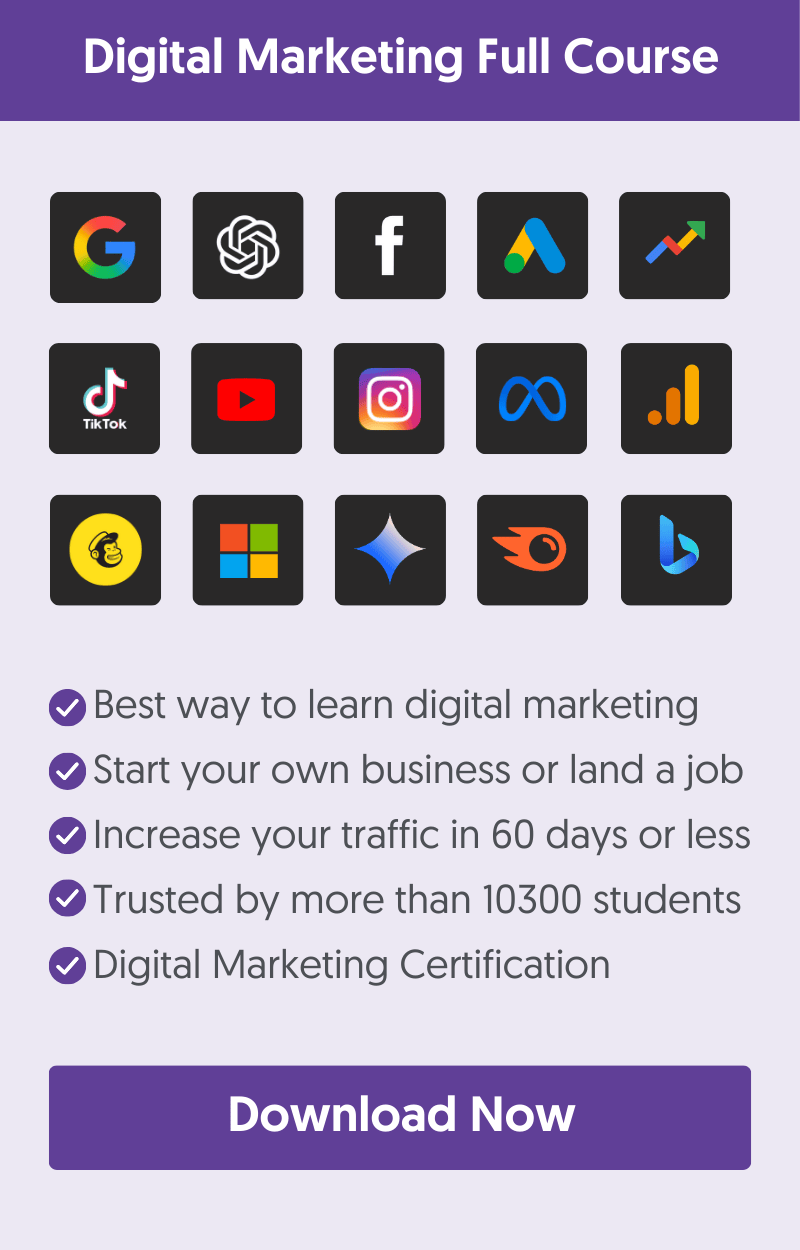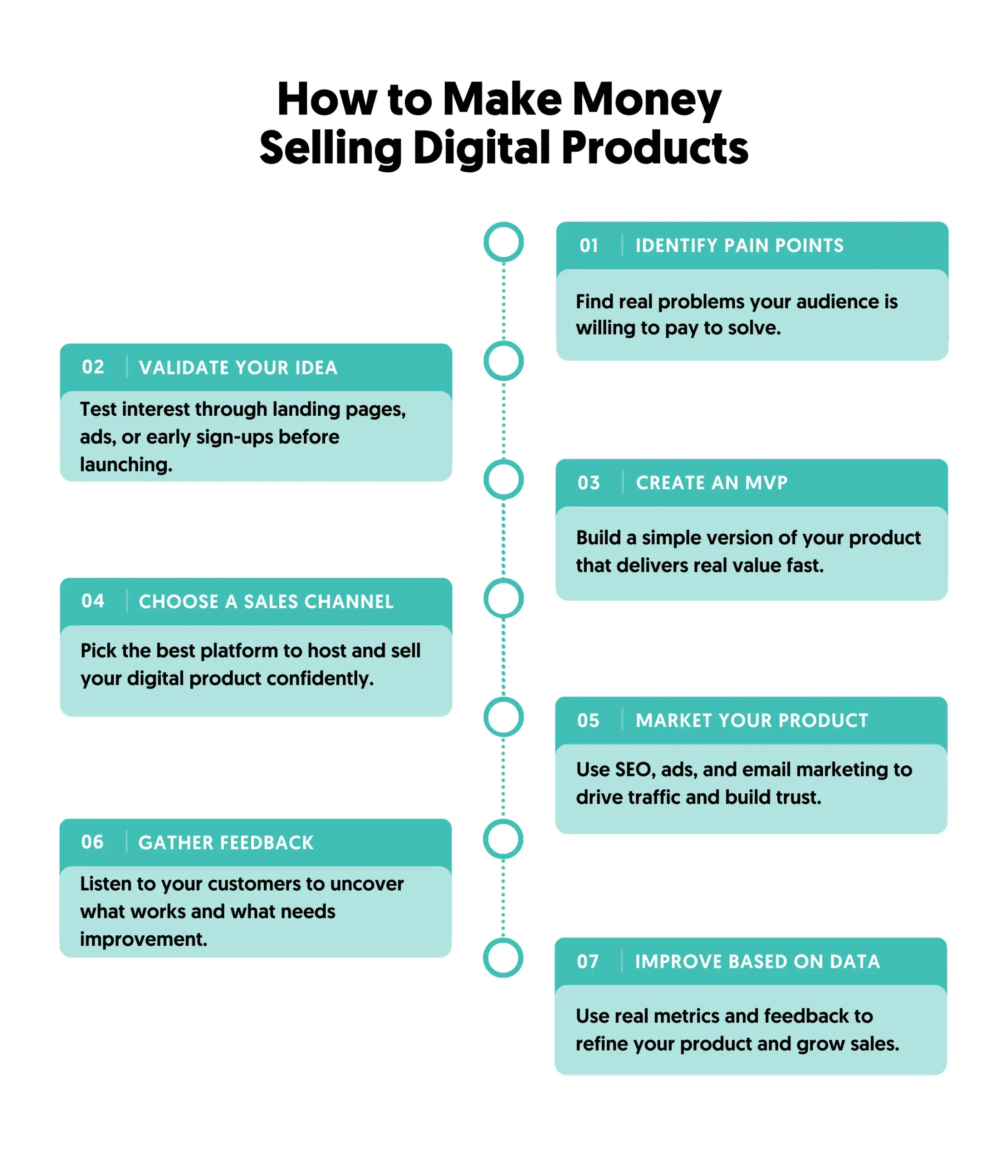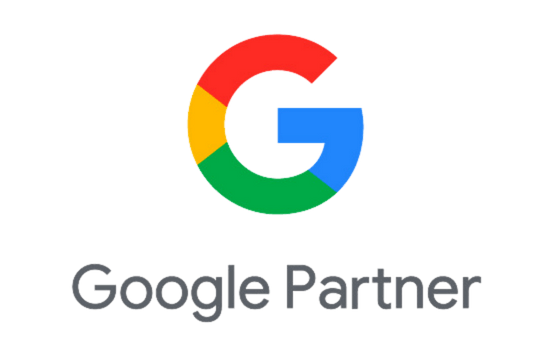Can you really make money selling digital products online? In this step-by-step guide, I’ll show you exactly how to sell digital products and make money based on 15+ years of experience selling eBooks, online courses, and AI tools.
TL;DR: To sell digital products and make money online, start by identifying a pain point, validating your idea, and creating a simple product that delivers results. Use proven marketing channels like SEO, email, and paid ads to attract buyers and then refine your offer using customer feedback for long-term growth.
I started selling digital products more than 15 years ago, long before “digital creator” was a buzzword.
My first product was a simple SEO eBook. I sold it on my website and promoted it via email to my subscribers, and it started generating sales from day one. That first success showed me what was possible.
Over the years, I expanded into online digital marketing courses and AI apps, reaching thousands of people worldwide and generating thousands in revenue.
I didn't just sell my own products but also made money selling other people's courses and online tools through affiliate marketing.
What You’ll Learn in This Guide
This is a practical roadmap based on my experience. You’ll learn how to choose the right product, create something valuable, and market it using proven methods that work in the AI era.
Whether you’re launching your first eBook, course, digital asset, or app, you’ll find everything you need to sell digital products successfully and make money online.
What Are Digital Products (and Why They’re So Profitable)
A digital product is any item you can create once and sell repeatedly online without physical inventory. Examples include eBooks, online courses, software, templates, memberships, stock photos, online tools, and mobile apps.
Unlike physical goods, digital products have low production costs and high profit margins. Once created, they can be delivered instantly to customers anywhere in the world, 24/7.
Why Digital Products Are So Profitable
Digital products are incredibly profitable because they can be sold repeatedly without additional effort. Once you create your eBook, course, or app, there are no inventory, packaging, or shipping expenses, so most of the revenue becomes profit.
In many cases, margins can exceed 70%, making digital products one of the most scalable and cost-effective business models online.
Beyond the high margins, digital products offer flexibility and freedom that physical products can’t match. You can sell to a global audience instantly, update or improve your product anytime, and even automate the entire sales process to generate income while you sleep.
Do They Still Work?
Many people believe that AI destroyed digital products, but this is far from the truth. On the contrary, you can now use AI to accelerate product creation and marketing.
Research studies also agree. According to a recent report by Grand View Research, the global digital content creation market is expected to reach $69.80 billion by 2030, growing at a 13.9% annual rate.
In another report, the e-learning market is projected to reach US$334.96 billion by 2030, growing at a compound annual growth rate of about 21.7 %.
So, yes, there is still strong demand for digital products, and from experience, I can tell you it's a business model worth exploring.
How To Make Passive Income Selling Digital Products
- Identify Pain Points Your Audience Will Pay to Solve
- Validate Your Digital Product Idea Before Building It
- Create an MVP (Minimum Viable Product)
- Choose the Best Platform to Sell Digital Products
- Market and Promote Your Digital Products
- Gather Feedback and Make a Valuable Product
1. Identify Pain Points Your Audience Will Pay to Solve
If you want to succeed in selling digital products and make money, you need to understand a simple concept.
Your products need to solve a real problem that people are willing to pay to solve. If you can nail this, you dramatically increase your chances of making a product that sells.
When I launched my first SEO eBook, I didn’t start with an idea, but with a pain point. I kept getting the same question from readers: “How can I rank my website higher without spending money on ads?” That single problem turned into a digital product that sold thousands of copies.
People didn't buy the book to get their website to the top of Google magically, but they wanted a framework to follow and guidance from someone who had done this before.
The truth is, people buy digital products because they want change, solutions, and sometimes hope.
They’re looking for a faster path, a proven process, or reassurance that someone who’s already done it can help them do the same.
Whether it’s saving time, avoiding mistakes, or finally reaching a goal they’ve struggled with, your product becomes the bridge between where they are now and where they want to be.
That’s why your first step is to identify those specific pain points and confirm that they’re strong enough to motivate a purchase.
Here is how to do it:
Listen to your audience directly - If you already have a blog, YouTube channel, or email list, review the questions you receive most often. Look for patterns in your inbox, comments, or support tickets. The best product ideas often come from recurring questions.
Explore online communities - platforms like Reddit or Facebook Groups are gold mines for uncovering pain points. Search for threads in your niche and pay attention to what frustrates people.
For example, if you’re in the fitness niche, you might notice many posts saying, “I can’t stay consistent with my workouts.” That’s not just a complaint, it’s a potential product idea for a habit-building fitness app or guide.
Study competitors’ reviews - Visit marketplaces like Gumroad, Etsy, or Udemy and look at reviews for similar products. Negative reviews often reveal gaps you can fill (“I wish this course had templates” or “The instructions weren’t clear”). Positive reviews show what people truly value.
Use keyword research - Tools like Google Keyword Planner, Ahrefs, or Semrush show what people are searching for. Long-tail keywords that start with “how to” or “best way to” often reveal problems waiting for solutions.
2. Validate Your Digital Product Idea Before Building It
Once you have an idea, the next step is to validate it before creating it. This is a crucial step that will save you money, time, and frustration by preventing you from building something nobody will buy.
Before I launched my first SEO eBook, I wanted to be sure people were actually interested in buying it. Instead of writing the entire book first, I started with a simple landing page and sales funnel.
Here’s what I did:
I created a basic page describing what the eBook would include, added a few persuasive bullet points, and placed a “Buy Now” button. The button didn’t lead to a checkout page, but it still tracked clicks. Then I added a banner to my blog and linked it to that page.
Over the next few days, I monitored how many people visited the page and how many clicked the “Buy Now” button. The interest was consistent, and that’s when I knew it was worth creating the product.
A few months later, once I launched, sales started coming in immediately.
How You Can Replicate This Process
If you already have a website or blog, follow a similar approach:
- Create a simple landing page describing your digital product idea. Include what it solves, who it’s for, what buyers will gain, and pricing information.
- Add a clear call-to-action button (“Sign Up”, "Download", or “Buy Now”) and track button clicks with Google Analytics.
- Promote it through your blog, newsletter, or social channels for a few days.
Even 50–100 visits can give you a clear picture. If people click or sign up, you’ve validated your idea.
If not, you can tweak your landing page, messaging, and pricing, but if there is still no interest, it is a good sign that the particular idea isn't worth pursuing.
If You Don’t Have a Blog or Traffic
You can still test your idea by running Facebook or Google ad campaigns. Actually, this method is highly recommended, even if you have traffic to your website.
Create a basic ad that leads to your landing page. Spend a low monthly budget of $200-$300 and see how many people click on your ads, what the average CPC is, and how many people click your CTA button.
This approach has two big benefits:
First, you get real-world data before you build anything. If your CPC is high, you may have difficulty making many sales, and that's a big showstopper.
Second, when creating your ads, you will gain a better understanding of how to market your product and which product features to add to make your messaging more appealing to your audience.
Very often, creators build a product, and when it comes to creating ads or landing pages, they realise it's missing features and isn't as appealing as they initially thought.
Why This Works Better Than Copying Competitors
A common practice for validating your product idea is to look at competitors. If they are consistently running ads, this is a good indicator that there is demand for the product, and if it works for them, you can replicate their funnels and achieve the same results.
The problem is, what sells for others might not perform the same way for you. Different audiences, brand authority, and marketing channels produce different results.
So, my recommendation is to conduct your competitor analysis, but always run your own validation test so you’ll see firsthand whether your idea works for your audience and platform.
3. Create an MVP (Minimum Viable Product)
Once you’ve validated your idea and seen real interest, the next step is to create your MVP — Minimum Viable Product.
An MVP is the simplest version of your product that still delivers value. It doesn't have to be perfect, but it should prove your concept and start to sell as early as possible.
When I created my first SEO eBook, I didn’t spend months designing layouts or writing hundreds of pages. I focused on the most important thing: solving the reader’s problem by providing actionable advice backed by facts.
The first version was about 40 pages long, written in plain text without a fancy design. But it sold because it delivered value.
Later, as sales grew, I improved it with graphics and examples, and eventually turned it into a comprehensive digital marketing course.
Here is what you should do: Think about the single biggest problem your audience wants to solve: that’s your MVP’s core.
- If you’re creating an online course, start with your most actionable lessons.
- If it’s an app, include only the features users truly need.
- If it’s an eBook, focus on clarity and outcomes rather than design.
Then create a product that feels legitimate and helps users achieve a tangible goal.
Even if your product still lacks features, ensure that purchasing, downloading, and first use feel seamless.
Run through it yourself and ask:
- Is checkout fast and mobile-friendly?
- Does the download or access email arrive immediately?
- Are instructions or login steps clear for new customers?
4. Choose the Best Platform to Sell Digital Products
Once your MVP is ready, you need a place to sell it. The truth is, there’s no “one-size-fits-all” solution.
The best platform depends on what you’re selling, how hands-on you want to be, and how much control you want over pricing and branding.
The most common platforms for selling digital products, ranked by effectiveness, are:
1. Selling From Your Own Website
This is the route I recommend if you want full control and long-term growth.
Your website gives you:
- Ownership: You control the customer data, pricing, and design.
- SEO benefits: Every sale builds your brand’s online visibility.
- Flexibility: You can add upsells, blog posts, and funnels later.
For my early eBooks, I used WordPress with a PayPal integration. Later, I switched to WooCommerce and LearnDash for more features.
2. Using Marketplaces
If you don’t want to manage a website right away, digital marketplaces are a great starting point.
Some popular options include:
- Gumroad – ideal for eBooks, templates, and toolkits.
- Etsy – great for printables and creative downloads.
- LearnWorlds, Teachable, or Kajabi – perfect for selling online courses.
- AppSumo – good for software and tools if you’re looking to reach early adopters.
The advantages of marketplaces are their audience and simplicity: they handle payment processing and product delivery, and already have an audience.
The downside is that you pay fees and have limited control over branding.
If you’re just starting and want to test an idea fast, a marketplace can help you build momentum. Later, you can transition to your own site to scale and improve margins.
3. Hybrid Approach
Many successful creators use a hybrid strategy. They are launching on a marketplace to gain early traction, then migrating to their own platform once sales stabilize.
5. Market and Promote Your Digital Products
When you go through the process of selling digital products once, you'll realize that finding an idea and building a product is the easy part.
The most challenging part is marketing. Even the best product won’t sell if people don’t know it exists.
After launching multiple eBooks, courses, and apps, I learned that success doesn’t depend on how great your product is but on how effectively you promote it.
Here are the marketing channels that have worked best for me over the years.
SEO and Content Marketing
Content marketing was the foundation of my first successful product launch. Before I ever ran ads, I focused on publishing SEO-optimized blog posts that answered real questions from my audience. Each post solved a specific problem and linked naturally to my eBook as the next step.
If you’re just starting, focus on creating helpful content that matches your product’s topic. For example, if you sell an online course about productivity, write blog posts like “How to Stay Focused When Working from Home” or “5 Tools That Help You Get More Done.”
While the way search results are structured today, with AI-generated answers, makes it more difficult to get visibility, SEO traffic remains the most valuable for selling digital products.
Visitors who find you through search are already looking for solutions, and they’re far more likely to buy.
So, despite what you might read that 'SEO is dead', it still works, but it needs more time. Take inspiration from our case study on how we increased organic traffic to 5 figures using SEO.
PPC Marketing
Paid advertising is the fastest way to get traffic and nowadays the only way to scale your digital products business with confidence.
Once you can control your customer acquisition cost (CAC) and still make a profit, you can grow as fast as your budget allows. From there, channels like SEO and email marketing can help you increase overall profitability.
You don’t need a big budget. Start small but track clicks, conversions, and engagement to see which ad headlines and visuals work best.
Focus on testing one platform at a time. This keeps your budget focused and helps you analyze results more accurately.
Facebook Ads are ideal for reaching specific audiences based on interests, while Google Ads target people who are actively searching for solutions.
Over time, you can use retargeting campaigns to reach visitors who viewed your page but didn’t buy. These warm audiences often convert at a much higher rate since they already know your brand.
The key to success with PPC is consistency and optimization. Test new headlines, visuals, and landing pages regularly. Small improvements in click-through and conversion rates can dramatically lower your costs and increase your profits over time.
Social Media Marketing
Social media gives you a free and effective way to build awareness. Pick one or two platforms where your audience already spends time. For most digital creators, that’s YouTube, Instagram, or TikTok.
Create short, valuable posts or videos that teach something useful, then guide followers to your website or product page.
Don’t just promote; engage. Answer questions, respond to comments, and show behind-the-scenes glimpses of your work.
People buy from creators they trust, and social media is where that trust begins.
Influencer Marketing
If you want to reach a wider audience quickly, partner with influencers or creators in your niche. You don’t need celebrity-level endorsements. Micro-influencers with smaller but loyal audiences often drive better results.
When I started promoting my courses, I collaborated with bloggers and YouTubers who already created content around SEO and digital marketing. They reviewed my course, shared their experience, and linked to my landing page.
Here is a review video that generated over 500K views on YouTube and sales.
Offer them an affiliate commission for each sale. This approach builds credibility fast because it’s based on trust and recommendation rather than direct advertising.
Email Marketing
Email marketing has consistently been my highest-converting channel. Your goal should be to collect emails through lead magnets like free checklists, guides, or free tools related to your product and then nurture those leads through automated email campaigns.
Start by delivering value: share actionable tips, quick wins, or personal insights. Gradually introduce your product as the next step for those who want deeper results.
I’ve used this same approach for every major launch, and it still drives sales years later.
Email lets you build a personal relationship with your audience, and once people trust you, they’re far more likely to buy.
Affiliate Marketing
As your business grows, you can expand your reach by partnering with people who promote your product in exchange for a commission. It works similarly to influencer marketing, but instead of paying influencers to promote, affiliates are paid only when they generate sales.
This performance-based model makes it a low-risk, high-return way to scale your digital product business.
6. Gather Feedback and Make a Valuable Product
After you’ve launched your first version and started making sales, your next goal is to create a truly valuable product by listening to your customers.
When I released my first SEO eBook, I was thrilled to see sales coming in, but I knew it could be better. I started collecting feedback from every customer.
Some wanted more examples, others asked for visuals or templates. Those comments became my roadmap. Every improvement I made came directly from what my readers asked for.
That process turned a basic eBook into a full SEO training course and later, into a digital marketing academy that still runs today.
The lesson? Your customers are your best product developers.
There are many ways to gather feedback. This is what I do:
In the early days of each launch, I personally email every new customer, not through an automated message, but a short, friendly email asking for their honest opinion.
This personal approach often leads to valuable insights I wouldn’t get otherwise. People are far more willing to share feedback when they feel like they’re talking to a real person, not a system.
On all my products, I include a built-in feedback form that lets users submit bugs, feature suggestions, or rate their overall experience. This gives me ongoing data on what’s working and what needs improvement, even long after launch.
From time to time, I also send simple surveys to my customers and email subscribers. These aren’t long forms, just short questionnaires that help me understand what new features or products they’d like to see next. Many of my best updates and new course topics have come directly from these responses.
And while my refund rate has always been low, I treat every refund request as an opportunity to learn. Whenever someone requests a refund, I personally reach out to understand what went wrong and how we can improve the product.
Lessons Learned From Selling Digital Products
After more than 15 years of selling eBooks, courses, and apps, I’ve learned that success doesn’t come from luck or timing, but it comes from consistency.
Here’s what matters the most:
- Start small and launch early. Waiting for perfection kills momentum.
- Focus on value. Products that solve problems always sell.
- Keep improving. Every update makes your product stronger and your audience more loyal.
Selling digital products is one of the most rewarding business models, once you understand that it’s a long game. Create something useful, listen to your audience, and keep refining.
If you do that, the income becomes consistent, and the growth never really stops.




